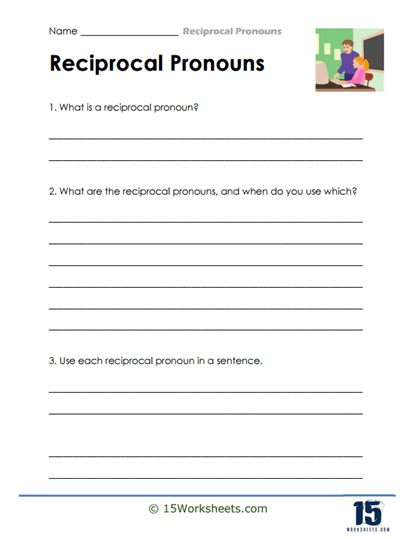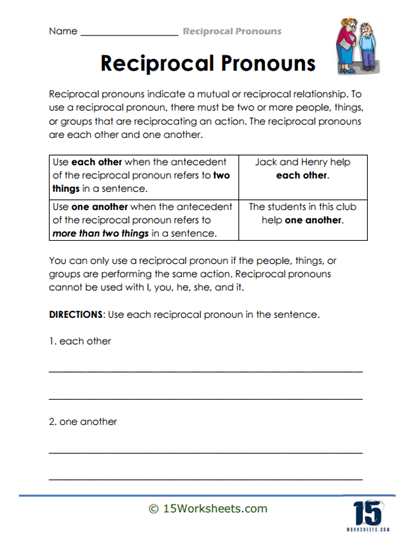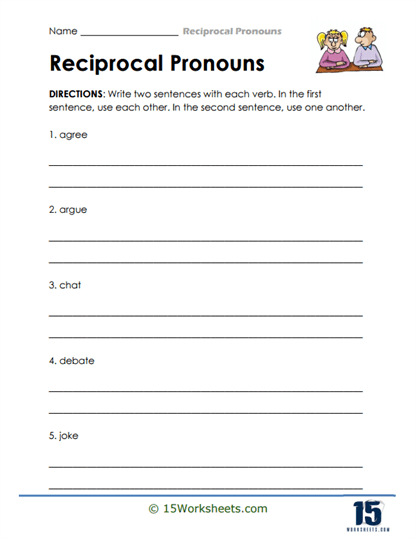Reciprocal Pronouns Worksheets
About These 15 Worksheets
This worksheets series is designed to help students understand and master the use of reciprocal pronouns, which are essential in expressing mutual actions or relationships between two or more subjects. This collection offers a variety of engaging exercises that allow students to practice identifying, using, and correcting reciprocal pronouns in sentences. The worksheets cater to different learning levels, providing students with opportunities to solidify their understanding through true or false statements, sentence corrections, and multiple-choice questions. Each worksheet is crafted to gradually build a student’s confidence and competence in using reciprocal pronouns correctly in both written and spoken English.
For example, one worksheet in the collection asks students to underline the reciprocal pronoun in each sentence, reinforcing their ability to identify these pronouns in context. Another worksheet focuses on correcting sentences where the reciprocal pronoun has been misused, encouraging students to apply their knowledge actively. There are also worksheets that guide students in choosing the correct reciprocal pronoun between “each other” and “one another,” depending on the context, further solidifying their understanding of when and how to use these pronouns.
This collection not only aids in reinforcing grammar skills but also enhances the student’s ability to comprehend and produce more complex sentences that involve reciprocal actions or relationships. The exercises are designed to promote critical thinking, as students must often choose between similar pronouns or correct errors that might be subtle. The variety of activities ensures that learning remains dynamic and engaging, catering to different learning styles and keeping students motivated.
In addition to the reciprocal pronouns exercises, the collection includes worksheets on related topics, such as reflexive pronouns, possessive pronouns, and subject-object pronoun distinctions. These topics naturally complement the study of reciprocal pronouns, offering students a more comprehensive understanding of pronoun usage in English. For instance, students might work on distinguishing between sentences that require a reciprocal pronoun versus those that require a reflexive pronoun, thus deepening their grammatical knowledge.
Each worksheet in this collection is available in PDF format, making them easy to view, download, and print. This accessibility is ideal for teachers, homeschoolers, and students, providing a flexible resource that can be used in various educational settings. Whether used as part of a larger lesson plan or as a standalone practice tool, these worksheets are a valuable resource for anyone looking to improve their understanding of reciprocal pronouns and related grammatical concepts.
The activities are crafted to be self-contained, allowing for both independent practice and guided instruction. This versatility ensures that students can work through the materials at their own pace, with the ability to revisit concepts as needed. The worksheets are designed to be both educational and enjoyable, encouraging students to see grammar not just as a set of rules but as a way to enhance their communication skills.
The variety of exercises, from identifying and correcting pronouns to choosing between similar pronouns, ensures that students gain a thorough understanding of this essential aspect of grammar. With the added benefit of being easily accessible in PDF format, these worksheets are a valuable tool for any educational setting.
What Are Reciprocal Pronouns?
Reciprocal pronouns play a crucial role in English grammar, serving as a tool to express mutual actions or relationships between two or more subjects within a sentence. These pronouns are unique in that they specifically indicate that the action of the verb is being performed back and forth among the subjects. The two primary reciprocal pronouns in English are “each other” and “one another.” They help avoid redundancy in language by allowing speakers and writers to convey mutual interactions without needing to repeat the subjects or actions.
To understand the function of reciprocal pronouns, consider how they simplify sentence construction. Imagine trying to describe a situation where two people are interacting with each other without using a reciprocal pronoun. For example, instead of saying “Sarah respects John, and John respects Sarah,” you can simply say “Sarah and John respect each other.” The use of “each other” makes the sentence more concise and easier to understand, while still conveying the same meaning. This is especially useful in writing and speech, where clarity and brevity are often essential.
The distinction between “each other” and “one another” traditionally lies in the number of subjects involved. “Each other” is generally used when referring to a reciprocal relationship between two subjects. For instance, “The two friends always help each other with homework” clearly indicates that there are only two people involved in this mutual action. On the other hand, “one another” is used when the reciprocal relationship involves three or more subjects. An example would be, “The members of the team encourage one another during the game,” which suggests that the encouragement is shared among all members of the team, not just between two individuals.
However, it’s important to note that in contemporary English usage, the distinction between “each other” and “one another” is often blurred. Many speakers and writers use the two interchangeably, even though traditional grammar guidelines suggest maintaining the distinction. For example, someone might say, “The three siblings support each other” instead of “support one another,” and this would be widely accepted in modern communication. This flexibility reflects the natural evolution of language, where rules sometimes adapt to common usage patterns.
Reciprocal pronouns are essential for maintaining the efficiency and fluidity of language. By using these pronouns, speakers and writers can convey complex interactions and relationships succinctly, without sacrificing clarity. They allow for a smoother flow of information, especially in contexts where multiple subjects are interacting in similar ways. Understanding and correctly using reciprocal pronouns can significantly enhance both written and spoken communication, making expressions of mutual actions clear and effective.















